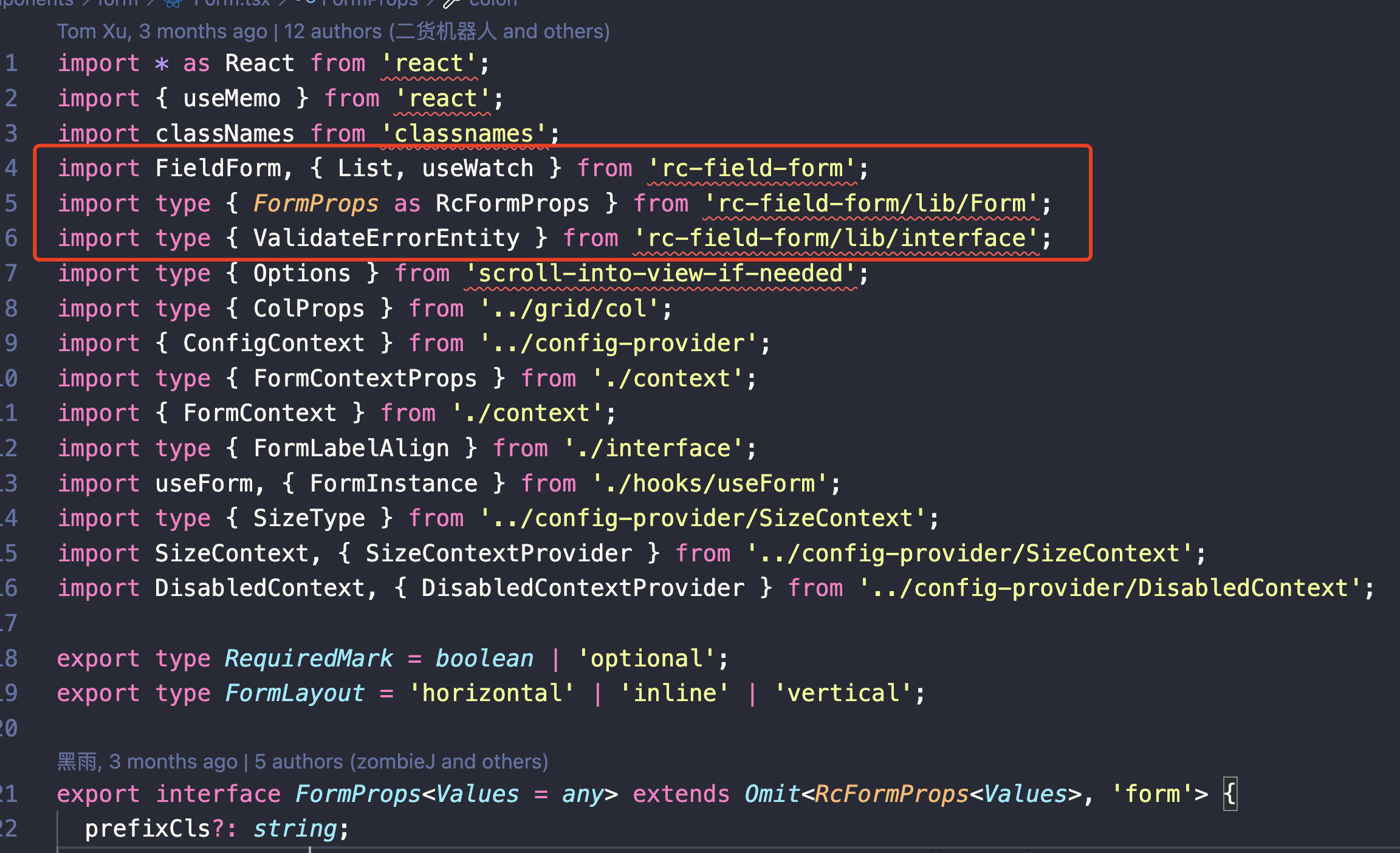Antd Form相信大家并不陌生,在中后台业务中,表单页面经常用到,但是大家知道它是如何设计和实现的吗?本文并不涉及具体源码分析,而是手把手带你实现一个简易版的Antd Form。
1、Form组件解决的问题
我们从官网摘下来一段Form代码,可以很清晰的看出一个简单的表单,主要是为了统一收集和校验组件的值。
<FormonFinish={(values) => {console.log('values', values)}}><Form.Itemlabel="Username"name="username"rules={[{ required: true, message: 'Please input your username!' }]}><Input /></Form.Item><Form.Itemlabel="Password"name="password"rules={[{ required: true, message: 'Please input your password!' }]}><Input.Password /></Form.Item><Form.Item><Button type="primary" htmlType="submit">Submit</Button></Form.Item></Form>
那么它是如何做到统一收集和校验呢?原理很简单,只需要通过监听表单组件的onChange事件,获取表单项的 value,根据定义的校验规则对 value 进行检验,生成检验状态和检验信息,再通过setState驱动视图更新,展示组件的值以及校验信息即可。
2、Antd Form 是怎么实现的
要实现上面的方案需要解决这几个问题:
- 如何实时收集组件的数据?
- 如何对组件的数据进行校验?
- 如何更新组件的数据?
- 如何跨层级传递传递
- 表单提交
3、目录结构

- src/index.tsx用于放测试代码
- src/components/Form文件夹用于存放Form组件信息
export type StoreValue = any;
export type Store = Record
export interface Callbacks
export interface FormInstance
<a name="eb82d8a3"></a># 5、数据仓库因为我们的表单一定是各种各样不同的数据项,比如input、checkbox、radio等等,如果这些组件每一个都要自己管理自己的值,那组件的数据管理太杂乱了,我们做这个也就没什么必要性了。那要如何统一管理呢?<br />其实就是我们自己定义一个数据仓库,在最顶层将定义的仓库操作和数据提供给下层。这样我们就可以在每层都可以操作数据仓库了。<br />数据仓库的定义,说白了就是一些读和取的操作,将所有的操作都定义在一个文件,代码如下:```typescript// src/components/Form/useForm.tsimport { useRef } from "react";import type { Store, NamePath, Callbacks, FormInstance } from "./interface";class FormStore {private store: Store = {};private callbacks: Callbacks = {};getFieldsValue = () => {return { ...this.store };};getFieldValue = (name: NamePath) => {return this.store[name];};setFieldsValue = (newStore: Store) => {this.store = {...this.store,...newStore,};};setCallbacks = (callbacks: Callbacks) => {this.callbacks = { ...this.callbacks, ...callbacks };};submit = () => {const { onFinish } = this.callbacks;if (onFinish) {onFinish(this.getFieldsValue());}};getForm = (): FormInstance => {return {getFieldsValue: this.getFieldsValue,getFieldValue: this.getFieldValue,setFieldsValue: this.setFieldsValue,submit: this.submit,setCallbacks: this.setCallbacks,};};}
当然,数据仓库不能就这么放着,我们需要把里面的内容暴露出去。这里用ref来保存,来确保组件初次渲染和更新阶段用的都是同一个数据仓库实例;
// src/components/Form/useForm.tsexport default function useForm<Values = any>(form?: FormInstance<Values>): [FormInstance<Values>] {const formRef = useRef<FormInstance>();if (!formRef.current) {if (form) {formRef.current = form;} else {const formStore = new FormStore();formRef!.current = formStore.getForm();}}return [formRef.current];}
6、实时收集组件的数据
我们先来定义一下表单的结构,如下代码所示:
// src/index.tsximport React from "react";import Form, { Field } from "./components/Form";const index: React.FC = () => {return (<FormonFinish={(values) => {console.log("values", values);}}><Field name={"userName"}><input placeholder="用户名" /></Field><Field name={"password"}><input placeholder="密码" /></Field><button type="submit">提交</button></Form>);};export default index;
定义了数据仓库,就要想办法在每一层都要拥有消费它的能力,所以这里在最顶层用context来跨层级数据传递。
通过顶层的form将数据仓库向下传递,代码如下:
// src/components/Form/Form.tsximport React from "react";import FieldContext from "./FieldContext";import useForm from "./useForm";import type { Callbacks, FormInstance } from "./interface";interface FormProps<Values = any> {form?: FormInstance<Values>;onFinish?: Callbacks<Values>["onFinish"];}const Form: React.FC<FormProps> = (props) => {const { children, onFinish, form } = props;const [formInstance] = useForm(form);formInstance.setCallbacks({ onFinish });return (<formonSubmit={(e) => {e.preventDefault();formInstance.submit();}}><FieldContext.Provider value={formInstance}>{children}</FieldContext.Provider></form>);};export default Form;
子组件来做存与取的操作。这里有个疑问,为什么不直接在input、radio这些组件上直接加入存取操作,非得在外面包一层Field(在正式的antd中是Form.Item)呢?这是因为需要在它基础的能力上扩展一些能力。
// src/components/Form/Field.tsximport React, { ChangeEvent } from "react";import FieldContext from "./FieldContext";import type { NamePath } from "./interface";const Field: React.FC<{ name: NamePath }> = (props) => {const { getFieldValue, setFieldsValue } = React.useContext(FieldContext);const { children, name } = props;const getControlled = () => {return {value: getFieldValue && getFieldValue(name),onChange: (e: ChangeEvent<HTMLInputElement>) => {const newValue = e?.target?.value;setFieldsValue?.({ [name]: newValue });},};};return React.cloneElement(children as React.ReactElement, getControlled());};export default Field;
这样我们就完成了数据收集以及保存的功能了。
很简单吧,我们来试一下onFinish操作!
7、完善组件渲染
我们来修改一下Form的代码,加入一条设置默认值:
// src/index.tsximport React, { useEffect } from "react";import Form, { Field, useForm } from "./components/Form";const index: React.FC = () => {const [form] = useForm();// 新加入代码useEffect(() => {form.setFieldsValue({ username: "default" });}, []);return (// ...省略...);};export default index;
来看一眼页面,发现我们设置的默认值并没有展示在表单中,但是我们提交的时候还是可以打印出数据的,证明我们的数据是已经存入到store中了,只是没有渲染到组件中,接下来我们需要做的工作就是根据store变化完成组件表单的响应功能。
我们在useForm中加入订阅和取消订阅功能代码;
// 订阅与取消订阅registerFieldEntities = (entity: FieldEntity) => {this.fieldEntities.push(entity);return () => {this.fieldEntities = this.fieldEntities.filter((item) => item !== entity);const { name } = entity.props;name && delete this.store[name];};};
forceUpdate的作用是进行子组件更新;
// src/components/Form/Field.tsx// ...省略...const [, forceUpdate] = React.useReducer((x) => x + 1, 0);useLayoutEffect(() => {const unregister =registerFieldEntities &®isterFieldEntities({props,onStoreChange: forceUpdate,});return unregister;}, []);// ...省略...
当然光是注册是不够的,我们需要在设置值的时候完成响应;
// src/components/Form/useForm.tsxsetFieldsValue = (newStore: Store) => {this.store = {...this.store,...newStore,};// 新加入代码// update Filedthis.fieldEntities.forEach((entity) => {Object.keys(newStore).forEach((k) => {if (k === entity.props.name) {entity.onStoreChange();}});});};
8、加入校验功能
到现在为止,我们发现提交表单还没有校验功能。表单校验通过,则执行onFinish。表单校验的依据就是Field的rules,表单校验通过,则执行onFinish,失败则执行onFinishFailed。接下来我们来实现一个简单的校验。
修改代码结构,添加校验信息;
import React, { useEffect } from "react";import Form, { Field, useForm } from "./components/Form";const nameRules = { required: true, message: "请输入姓名!" };const passworRules = { required: true, message: "请输入密码!" };const index: React.FC = () => {const [form] = useForm();useEffect(() => {form.setFieldsValue({ username: "default" });}, []);return (<FormonFinish={(values) => {console.log("values", values);}}onFinishFailed={(err) => {console.log("err", err);}}form={form}><Field name={"username"} rules={[nameRules]}><input placeholder="用户名" /></Field><Field name={"password"} rules={[passworRules]}><input placeholder="密码" type="password" /></Field><button type="submit">提交</button></Form>);};export default index;
添加validateField方法进行表单校验。注意:此版本校验只添加了required校验,后续小伙伴们可以根据自己的需求继续完善哦!
// src/components/Form/useForm.tsx// ...省略...validateField = () => {const err: any[] = [];this.fieldEntities.forEach((entity) => {const { name, rules } = entity.props;const value: NamePath = name && this.getFieldValue(name);let rule = rules?.length && rules[0];if (rule && rule.required && (value === undefined || value === "")) {name && err.push({ [name]: rule && rule.message, value });}});return err;};
我们只需要在form提交的时候判断一下就可以啦;
submit = () => {const { onFinish, onFinishFailed } = this.callbacks;// 调用校验方法const err = this.validateField();if (err.length === 0) {onFinish && onFinish(this.getFieldsValue());} else {onFinishFailed && onFinishFailed(err);}};
密码为空时的实现效果;
账号密码都不为空时的实现效果;
做到这里,我们已经基本实现了一个Antd Form表单了,但是细节功能还需要慢慢去完善,感兴趣的小伙伴们可以接着继续向下做!
9、总结
其实我们在看Antd Form源码的时候会发现它是基于rc-field-form来写的。所以想继续向下写的小伙伴可以下载rc-field-form源码,边学习边写,这样就可以事半功倍了,攻克源码!


